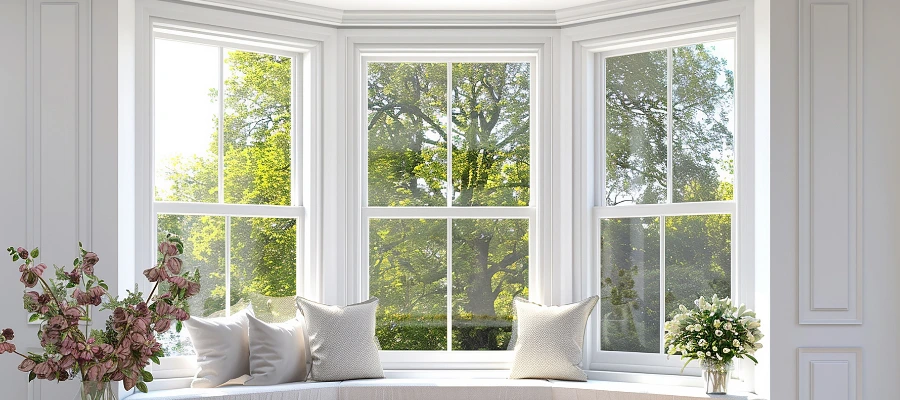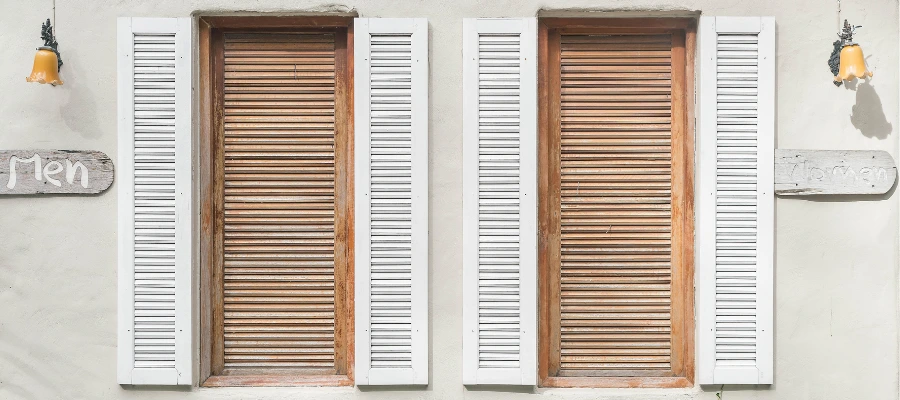Windows are crucial components of every building and dictate how much light and ventilation enters it. They also affect the aesthetic quality and finish of buildings. In the modern AEC (Architecture, Engineering and Construction) industry, numerous types of windows are available, each with different qualities, visual qualities, functionality and cost. Continue reading to learn about important window components, the different kinds of windows most commonly used in home construction today and their properties.
Understanding the Different Types of Window Components
Before exploring the various types of windows used in home construction, it is important to first understand the terminology of components that make up a window. Some of the important ones are:
- Sill: A sill is a horizontal element that forms the base of a window and supports the window’s entire load. It is generally made of PCC, bricks or stones.
- Lintel: This is the horizontal structural element that spans across the top of a window’s opening and helps transfer loads from the wall above it to the sides of a window. A lintel prevents a window opening from collapsing and can be made of materials like stone, concrete or bricks.
- Window Frame: A frame is the portion of the window that is fixed to the wall. It can be made with different materials like wood, uPVC, steel and aluminium.
- Window Shutter: This is the movable portion of a window which allows ventilation inside a building upon being opened. A window shutter can be completely solid and opaque or have a frame (made of wood, uPVC, etc.) that encases glass or other similar materials.
- Transoms and Mullions: A transom is a horizontal element that divides the window frame or shutter into sections, while a mullion is a vertical member that divides the window frame or shutter.
Types of Windows Based on Movement Type
Some of the common types of windows for home spaces based on how they operate are:
Sliding Window
The shutters in a sliding window slide over one another along channels placed at the bottom and top of the window frame (or at the sides in a vertical sliding window). Such windows are ideal for tight spaces where the window cannot practically be opened outwards or inwards. However, the clear opening and ventilation provided by these windows are reduced to half. They are generally made with carbon steel, uPVC or aluminium frames.
Casement Window
A casement window frame has shutters that are fixed to it with side hinges. Also called hinged windows, these windows open 90-180° towards the outside or inside and allow maximised cross ventilation. They are the most common house window types as they are easy to clean and maintain and can be made with a diverse range of materials like wood, steel and uPVC.
Pivot Window
A pivot window has a vertical or horizontal central axis along which the window shutter rotates to open or close. When the shutter of such a window is opened, it projects equally inside and outside, intersecting the window frame perpendicularly. As a result, these windows may create visual barriers in their openings, which would partially obstruct the flow of natural light and air.
Fixed Windows
As the name suggests, a fixed window cannot be opened and is typically located at inaccessible heights/ locations. Such a window is generally designed for the purpose of maximising natural light and/ or for enhancing the architectural aesthetics of spaces. Different types of window glass, such as frosted, fluted and coloured, are often used here.
Single Hung Windows
A single hung window has two window shutters one below the other, in which the top one is fixed and the bottom one can slide up and down to open/ close. Such windows are ideal for spaces like bathrooms and kitchens, where the window height is larger and only the bottom shutter can be accessed easily.
Double Hung Windows
A double hung window has two shutters placed one below the other, in which both of them can slide up and down. Such a window can be used as a passive design strategy in warm and humid climates, as hot air can rise up and go out through the upper opening, while the lower opening can bring in fresh, cool air, thus ensuring thermal comfort in homes.
Types of Windows Based on Material
A few commonly used types of window materials are:
Wood Windows
Wood is the oldest material used to make different types of window frames. Various types of wood can be used to make windows, some of the common ones of which are teak wood and Honnai wood. Wooden windows have high strength and provide good thermal insulation in buildings. However, they are expensive and require constant repainting or repolishing to ensure that they do not get degraded by pests (like termites and wood borers) or water, especially in regions with high moisture content.
Steel Windows
Steel is a metal alloy of aluminium and carbon. Windows made with steel are extremely strong and provide high levels of safety and security. However, steel windows are not very energy efficient, as they can conduct heat and allow it to escape from enclosed spaces more easily than other door window types.
uPVC Windows
uPVC (Unplasticised PolyVinyl Chloride) is the most commonly used material to make different types of doors and windows in modern construction. uPVC windows are extremely lightweight and affordable. However, they can undergo expansion and contraction in extreme weather conditions. Since uPVC is a type of plastic, its use also raises questions on sustainability.
Aluminium Windows
Aluminium is a naturally occurring metal that is commonly used to make doors and windows. Aluminium doors and windows are extremely lightweight and are available with very thin profiles, enabling larger clear openings. Various types of sliding windows with multiple tracks and channels can be made with aluminium. However, these windows are more expensive than steel and uPVC windows.
Kinds of Windows Based on Shape and Form
Some of the different types of windows based on their design are:
Bay Window
A bay window has window shutters that project out from a wall at three or more different angles. With limited space, bay windows have a higher number of glass panes and allow much more light and ventilation inside. Such windows form a recessed space inside, which can be used for diverse activities like sitting, working and sleeping.

French Window
A French window is a door type window, meaning that it can be used as an opening for entering and exiting spaces (apart from providing light and ventilation). They are full-height casement windows with hinges that allow them to open 90-180° outwards or inwards. In architecture, they are generally used to visually blur the boundary between outdoor and indoor spaces.
Jalousie Window/ Louvred Window
A jalousie or louvered window has thin horizontal or vertical strips that can be rotated. These strips or slats are generally made of opaque materials that match the window frame/shutter and can be adjusted to regulate the amount of light and air entering a space. Such windows are thus important elements of climate responsive architecture.

Dormer Window
Dormer windows are windows that are projected out from the side of sloping roofs, forming a vertical angle with the ground. Such home window styles are generally added to increase the usable area and bring in additional light in attic spaces, or to enhance the architectural aesthetics of pitched roofs.
Apart from these common styles of windows, other designs like arched windows, gabled windows and circular windows are also often used. Advancements in technology have enabled architects to explore new shapes and forms of windows in modern buildings.
Getting the Best Types of Windows in Your Project
Numerous different styles of windows are available in the market today. Choosing the right type of window requires the study of various factors, including local climate, architectural design style and project budget. The right selection is only possible with top construction companies like Brick & Bolt. Assisted by experienced architects and qualified contractors, Brick & Bolt assures that every project is expertly executed through its end-to-end construction services. To ensure that your home is built with innovative types of windows and using the best materials, reach out to Brick & Bolt today!

